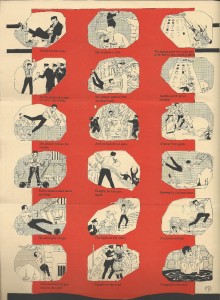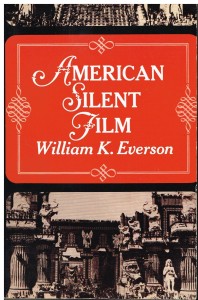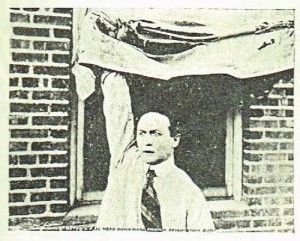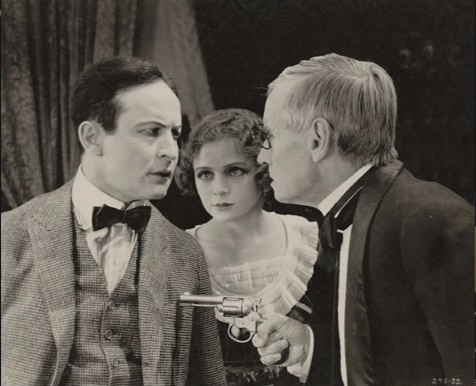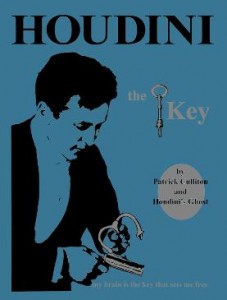 Yesterday, I got to meet The Great Patrick Culliton (aka Houdini’s Ghost) in person at the Magic Castle in Hollywood, California. It was a great experience:
Yesterday, I got to meet The Great Patrick Culliton (aka Houdini’s Ghost) in person at the Magic Castle in Hollywood, California. It was a great experience:
Patrick Culliton is the author of Houdini –the Key (published date October 31, 2010) which has a limited edition of 278 (Note: Houdini had a New York home at 278 West 113th Street in Harlem).
Houdini — the Key is intended as a reference book on the secrets of Houdini’s magic and escapes and I was fortunate enough to receive copy# 222 from Patrick on Friday the 22nd of June (which I was reminded was Harry and Bess’ anniversary).
In fact the only reason, this book has not sold out a long time a go, is because Patrick is maintaining a one per customer policy which I admire and appreciate. Earlier in the week, I emailed Patrick to see if he still had any copies left. He did and instead of mailing it to me, he offered to bring it to me or have me meet him at the Magic Castle to pick it up; we agreed to meet at the Castle for lunch on Friday, June 22nd.
Patrick believes that this book is a key because the notes and references, not to mention the 940 illustrations, will unlock a thousand doors for anyone researching Houdini and his methods. The book is incredible and I am going to have fun unlocking the doors.
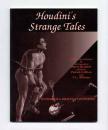 Patrick signed my book on top of the milk can (willed to the Magic Castle as an original Houdini prop) in the Houdini Séance Room. He was also gracious enough to sign my copy of Houdini’s Strange Tales that I purchased in Appleton Wisconsin in the 90’s.
Patrick signed my book on top of the milk can (willed to the Magic Castle as an original Houdini prop) in the Houdini Séance Room. He was also gracious enough to sign my copy of Houdini’s Strange Tales that I purchased in Appleton Wisconsin in the 90’s.
After signing the books, we went to the close-up room to catch a performance by Henok Negash. While waiting for the show to start, I learned that Patrick once owned 2 different sets of lobby cards for “The Grim Game” before he sold them.
After we saw the outstanding close-up show, we went upstairs to have lunch in the transformed Dante Room. Milt Larsen transformed the Dante room into a kind of big square round table where you never know who will show up. Patrick introduced me to a number of people, which I appreciated.
I learned that Patrick once owned an authentic substitution metamorphosis trunk before he sold it for quite a large amount of money.
 Patrick asked me if I had ever heard of the Witch’s house (aka The Spadena House) in Beverly Hills. He proceeded to tell me that it was originally built in 1921 to serve as the offices and dressing rooms for Irvin Willat’s film studio in Culver City, and was moved to its present location in 1934. I learned that Billie Love was married to Irvin Willat but divorced him when she met Howard Hughes; Howard and Billie made 2 films together. Note: Irvin Willat directed The Grim Game.
Patrick asked me if I had ever heard of the Witch’s house (aka The Spadena House) in Beverly Hills. He proceeded to tell me that it was originally built in 1921 to serve as the offices and dressing rooms for Irvin Willat’s film studio in Culver City, and was moved to its present location in 1934. I learned that Billie Love was married to Irvin Willat but divorced him when she met Howard Hughes; Howard and Billie made 2 films together. Note: Irvin Willat directed The Grim Game.
During lunch, I asked Patrick if he thought I would ever get to see The Grim Game; he told me that it used to be rented out and shown at magic clubs way back in the day. He confirmed that Larry Weeks (supposedly, Houdini’s biggest fan) is in a convalescent home and will not release his print. He mentioned that David Copperfield was interested in acquiring a print; this is not surprising that David who has one of largest Houdini Collections would be interested, but I don’t believe he has been successful. I would love to have a copy of the print, but I would settle for just seeing the film. I have been told by a few people now, that one day, I will get to see The Grim Game; I am looking forward to that day.
After lunch, I got a nice tour of the library and spent about a half-hour in the Houdini section looking through some booklets.
I then thanked Patrick for making my day and left with my treasures.
I am now ready to start unlocking the treasures found in Houdini — the Key!
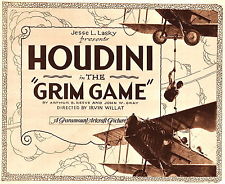 Our friends, Dorothy Dietrich and Dick Brookz of The Houdini Museum in Scranton, PA did a nice review of The Grim Game that they were fortunate enough to see several times in NYC, when they were living and performing in New York City, shown by collector Larry Weeks.
Our friends, Dorothy Dietrich and Dick Brookz of The Houdini Museum in Scranton, PA did a nice review of The Grim Game that they were fortunate enough to see several times in NYC, when they were living and performing in New York City, shown by collector Larry Weeks.
